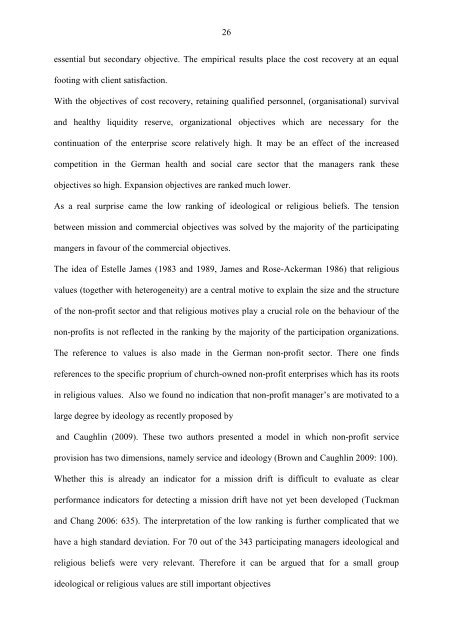Strategic responses to Performance Measurement in Nonprofit ...
Strategic responses to Performance Measurement in Nonprofit ...
Strategic responses to Performance Measurement in Nonprofit ...
You also want an ePaper? Increase the reach of your titles
YUMPU automatically turns print PDFs into web optimized ePapers that Google loves.
26<br />
essential but secondary objective. The empirical results place the cost recovery at an equal<br />
foot<strong>in</strong>g with client satisfaction.<br />
With the objectives of cost recovery, reta<strong>in</strong><strong>in</strong>g qualified personnel, (organisational) survival<br />
and healthy liquidity reserve, organizational objectives which are necessary for the<br />
cont<strong>in</strong>uation of the enterprise score relatively high. It may be an effect of the <strong>in</strong>creased<br />
competition <strong>in</strong> the German health and social care sec<strong>to</strong>r that the managers rank these<br />
objectives so high. Expansion objectives are ranked much lower.<br />
As a real surprise came the low rank<strong>in</strong>g of ideological or religious beliefs. The tension<br />
between mission and commercial objectives was solved by the majority of the participat<strong>in</strong>g<br />
mangers <strong>in</strong> favour of the commercial objectives.<br />
The idea of Estelle James (1983 and 1989, James and Rose-Ackerman 1986) that religious<br />
values (<strong>to</strong>gether with heterogeneity) are a central motive <strong>to</strong> expla<strong>in</strong> the size and the structure<br />
of the non-profit sec<strong>to</strong>r and that religious motives play a crucial role on the behaviour of the<br />
non-profits is not reflected <strong>in</strong> the rank<strong>in</strong>g by the majority of the participation organizations.<br />
The reference <strong>to</strong> values is also made <strong>in</strong> the German non-profit sec<strong>to</strong>r. There one f<strong>in</strong>ds<br />
references <strong>to</strong> the specific proprium of church-owned non-profit enterprises which has its roots<br />
<strong>in</strong> religious values. Also we found no <strong>in</strong>dication that non-profit manager‟s are motivated <strong>to</strong> a<br />
large degree by ideology as recently proposed by<br />
and Caughl<strong>in</strong> (2009). These two authors presented a model <strong>in</strong> which non-profit service<br />
provision has two dimensions, namely service and ideology (Brown and Caughl<strong>in</strong> 2009: 100).<br />
Whether this is already an <strong>in</strong>dica<strong>to</strong>r for a mission drift is difficult <strong>to</strong> evaluate as clear<br />
performance <strong>in</strong>dica<strong>to</strong>rs for detect<strong>in</strong>g a mission drift have not yet been developed (Tuckman<br />
and Chang 2006: 635). The <strong>in</strong>terpretation of the low rank<strong>in</strong>g is further complicated that we<br />
have a high standard deviation. For 70 out of the 343 participat<strong>in</strong>g managers ideological and<br />
religious beliefs were very relevant. Therefore it can be argued that for a small group<br />
ideological or religious values are still important objectives
















